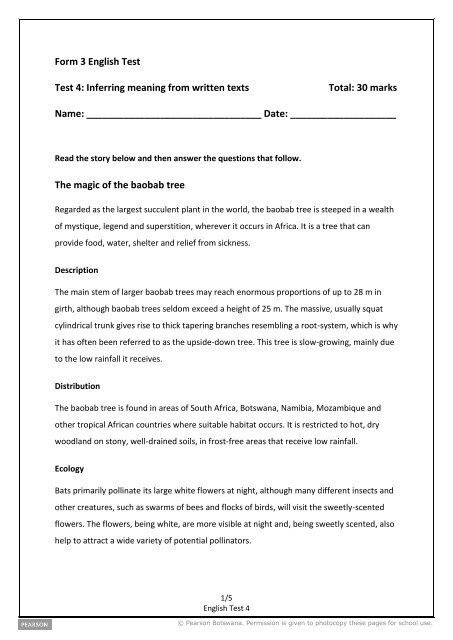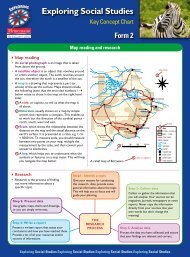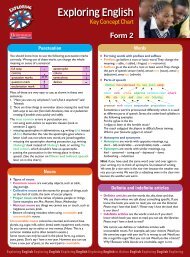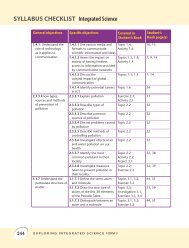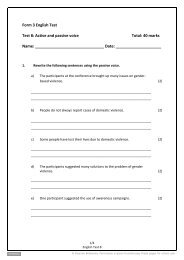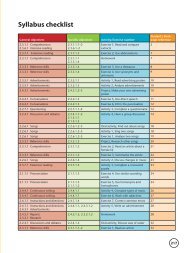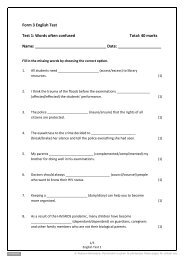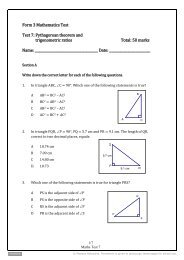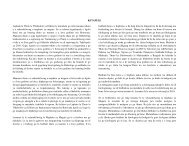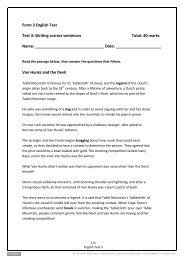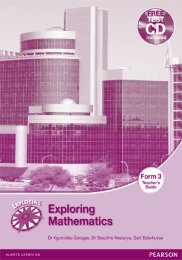Form 3 English Test Test 4: Inferring meaning from written ... - Pearson
Form 3 English Test Test 4: Inferring meaning from written ... - Pearson
Form 3 English Test Test 4: Inferring meaning from written ... - Pearson
Create successful ePaper yourself
Turn your PDF publications into a flip-book with our unique Google optimized e-Paper software.
<strong>Form</strong> 3 <strong>English</strong> <strong>Test</strong><br />
<strong>Test</strong> 4: <strong>Inferring</strong> <strong>meaning</strong> <strong>from</strong> <strong>written</strong> texts<br />
Total: 30 marks<br />
Name: _________________________________ Date: ____________________<br />
The s<br />
Read the story below and then answer the questions that follow.<br />
The magic of the baobab tree<br />
Regarded as the largest succulent plant in the world, the baobab tree is steeped in a wealth<br />
of mystique, legend and superstition, wherever it occurs in Africa. It is a tree that can<br />
provide food, water, shelter and relief <strong>from</strong> sickness.<br />
Description<br />
The main stem of larger baobab trees may reach enormous proportions of up to 28 m in<br />
girth, although baobab trees seldom exceed a height of 25 m. The massive, usually squat<br />
cylindrical trunk gives rise to thick tapering branches resembling a root-system, which is why<br />
it has often been referred to as the upside-down tree. This tree is slow-growing, mainly due<br />
to the low rainfall it receives.<br />
Distribution<br />
The baobab tree is found in areas of South Africa, Botswana, Namibia, Mozambique and<br />
other tropical African countries where suitable habitat occurs. It is restricted to hot, dry<br />
woodland on stony, well-drained soils, in frost-free areas that receive low rainfall.<br />
Ecology<br />
Bats primarily pollinate its large white flowers at night, although many different insects and<br />
other creatures, such as swarms of bees and flocks of birds, will visit the sweetly-scented<br />
flowers. The flowers, being white, are more visible at night and, being sweetly scented, also<br />
help to attract a wide variety of potential pollinators.<br />
1/5<br />
<strong>English</strong> <strong>Test</strong> 4<br />
© <strong>Pearson</strong> Botswana. Permission is given to photocopy these pages for school use.
Rainwater often collects in the clefts of the large branches, and travellers and local people<br />
often use this valuable source of water. It has been recorded that in some cases, the centre<br />
of the tree is purposely hollowed out to serve as a reservoir for water during the rainy<br />
season.<br />
Many references have made mention of the exceptional vitality of this tree, noting that<br />
even after the entire tree is cut down, it simply resprouts <strong>from</strong> the root and continues to<br />
grow; the same is noted of trees that have been blown over in storms.<br />
Determining the age of baobabs<br />
There is much speculation about the age of certain large baobab trees and their rate of<br />
growth. More recent work using carbon-dating techniques, as well as the study of core<br />
samples showing growth rings, suggest that a tree with a diameter of 10 m may be as old as<br />
2 000 years.<br />
1. Identify which statements about the baobab tree are true or false.<br />
a) The baobab tree grows well in areas of Africa that receive a high rainfall. (1)<br />
_______________<br />
b) Bats are attracted by the white flowers of the baobab tree. (1)<br />
_______________<br />
c) The baobab tree is called the inside-out tree. (1)<br />
_______________<br />
d) A tree with a diameter of 10 m is believed to be about 2 000 years old. (1)<br />
_______________<br />
2/5<br />
<strong>English</strong> <strong>Test</strong> 4<br />
© <strong>Pearson</strong> Botswana. Permission is given to photocopy these pages for school use.
e) The baobab is a small tree. (1)<br />
_______________ [5]<br />
2. Write down the <strong>meaning</strong> of the words in bold by working out their <strong>meaning</strong>s<br />
<strong>from</strong> the context in which they are used in the sentences.<br />
a) The main stem of larger baobab trees may reach enormous proportions<br />
of up to 28 m in girth, although baobab trees seldom exceed a height of<br />
25 m. (1)<br />
________________________________________________________________<br />
b) The massive, usually squat cylindrical trunk gives rise to thick tapering<br />
branches resembling a root-system. (2)<br />
________________________________________________________________<br />
________________________________________________________________<br />
c) Rainwater often collects in the clefts of the large branches. (1)<br />
________________________________________________________________<br />
d) After the entire tree is cut down, it simply resprouts <strong>from</strong> the root and<br />
continues to grow (1)<br />
________________________________________________________________ [5]<br />
3/5<br />
<strong>English</strong> <strong>Test</strong> 4<br />
© <strong>Pearson</strong> Botswana. Permission is given to photocopy these pages for school use.
3. The order of the following sentences has been jumbled. Re-order the<br />
sentences to form a paragraph about the superstitions surrounding baobab<br />
trees. (10)<br />
a) Because of these legends and superstitions, when inhabitants move <strong>from</strong><br />
one area to another, they often take seeds of the baobab with them,<br />
which they plant at their new homestead.<br />
b) There are many legends and superstitions surrounding the baobab tree.<br />
c) It is also believed that water in which the seeds have been soaked will<br />
offer protection against attacks by crocodiles.<br />
d) One example of this is the fact that, in some parts, that the baobab is<br />
worshipped as a symbol of fertility.<br />
e) Another superstition among certain people is that spirits inhabit the<br />
flowers of the baobab and that any person who picks a flower will be<br />
eaten by a lion.<br />
_________________________________________________________________<br />
_________________________________________________________________<br />
_________________________________________________________________<br />
_________________________________________________________________<br />
_________________________________________________________________<br />
_________________________________________________________________<br />
_________________________________________________________________<br />
_________________________________________________________________<br />
4. Below is a list of nouns. In each case, identify whether the noun is an<br />
abstract noun, a common noun, a proper noun or a collective noun. (10)<br />
a) vitality _____________________________________________________<br />
b) Botswana ___________________________________________________<br />
c) swarm _____________________________________________________<br />
4/5<br />
<strong>English</strong> <strong>Test</strong> 4<br />
© <strong>Pearson</strong> Botswana. Permission is given to photocopy these pages for school use.
d) tree _______________________________________________________<br />
e) Africa ______________________________________________________<br />
f) bat ________________________________________________________<br />
g) flower _____________________________________________________<br />
h) wealth _____________________________________________________<br />
i) flock _______________________________________________________<br />
j) pulp _______________________________________________________<br />
[Total: 30]<br />
5/5<br />
<strong>English</strong> <strong>Test</strong> 4<br />
© <strong>Pearson</strong> Botswana. Permission is given to photocopy these pages for school use.


